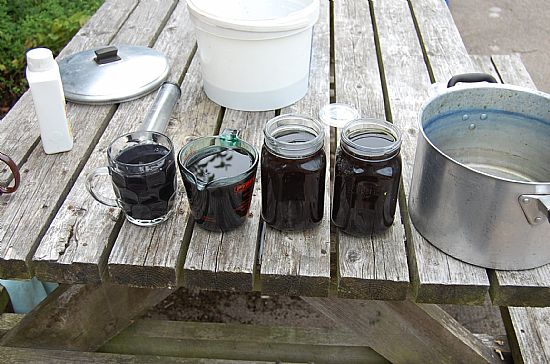woad pigment
This page is about how to extract woad pigment from the freshly harvested plant. Woad is easy to grow from seed, it's a biennial and the first year leaves are harvested to extract the pigment in August.

One woad plant gives just under a kilo of leaves in a good year, that's enough to get a usable amount of pigment.

Leaves are cut and rinsed.

The washed leaves are put in a pan of simmering water, don't let it boil. Turn the heat off after dropping the leaves in, put on the lid and leave for 10 minutes.

Strain the leaves through a collander to get out all the liquid.

Cool the liquid in the pan as quickly as possible to prevent the pigment breaking down, eg, in a sink of cold water with ice.

Add an alkaline to start the reaction, I'm using soda crystals here, ammonia and soda ash also work and theoretically lime should work as well.

Whisk the mixture for 10 minutes to get plenty of air into it. It'll go blue then bright green.

Pour the mixture into jars and leave it to settle, once the pigment has settled to the bottom some liquid can be poured off from the top.

The remaining liquid can be strained through filter paper to capture the pigment.

This is dry woad pigment. I now need to make it into a paint mixed with gypsum to achieve the Book of Kells colour, this is not going well so far. Below is some wool I dyed using a urine vat and got the colour I need but I have no idea how to apply the same principal to parchment, research is ongoing.

.jpg)
